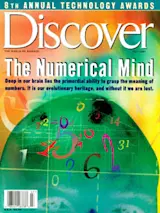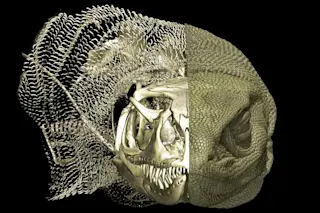Nobody knew precisely what had happened to Monsieur N.; perhaps he had just tripped, or maybe it was a stroke that had triggered the fall and the consequent blow to his head. He showed up at a hospital in Orléans one day in 1986 with a giant hematoma in his brain’s left hemisphere. The surgeons kept him from bleeding to death, but they couldn’t keep the lesion from growing even larger as they worked. By the time they were done, large parts of his left temporal, parietal, and occipital lobes--the rear half of the hemisphere, essentially--were useless. By the time Stanislas Dehaene came to see him, three years later, it was clear that N. was going to be severely impaired for life. It was a sad business: the man was in his early 40s, had been a successful salesman, was married with two young daughters-- only now his wife and kids had left him and he had been forced to move back in with his aging parents. Dehaene, a young neuropsychologist with a family of his own, felt the burden of sympathy as much as anyone would. But he also felt something else, and seven years later his face still brightens at the recollection. The first question he asked N. was What’s 2 plus 2? When N. answered 3, Dehaene knew he had landed a spectacular case.
That encounter took place at the Hôpital de la Salpêtrière in Paris, where Dehaene’s friend and research partner, Laurent Cohen, works as a neurologist. N.’s provincial doctor had sent him to the well-known medical center to seek help from the specialists. There was in fact little to be done for him, and treating N. was not Dehaene’s or Cohen’s job anyway. Their interest was in finding out what the trauma had left of his ability to process numbers. And as they questioned him closely, what was left turned out to be far more substantial than his performance on 2 plus 2 would have indicated. Even his dramatic failure on tests like that one was suggestive. N. might say that 2 plus 2 was 3, or that it was 5, but never that it was 9 or 47. He was never absurd.
N. had lost the ability to calculate--but not, it seemed, to approximate. Numbers existed for him only as approximations, which became increasingly fuzzy the larger they got. It was not just his arithmetic that was affected; his memory for number facts was similarly blurred. A year had about 350 days, a month 15 or 20. N. had no precise knowledge of the meaning of 9, but he knew that 9 children was too much for one mother and too few for a whole school. Dehaene asked him how many eggs in a douzaine, and he did not answer douze, the French word for 12; he said 6 or 10. Six or 10, though, isn’t 60 or a hundred. It is close to the mark. Somewhere deep within the posterior folds of his brain, N. still had an intuitive, almost primordial sense of numbers.
This was of course little consolation to him. When N. realized that he could not tell whether a number was odd or even, and was just guessing, he became so upset that Dehaene had to stop the experiment.
In the January 15, 1880, issue of the journal Nature, the British anthropologist Francis Galton published a curious little research note of the kind you could still publish a century ago. As part of a general study of mental imagery, Galton had passed around a questionnaire to a bunch of friends and acquaintances, asking them to report on whether they could see numbers and if so in what way. Some of them could, it seemed, mostly the women. (I have been astonished to find how superior women usually are to men in the vividness of their mental imagery and their powers of introspection. . . . Galton wrote. The former usually show an unexpected amount of intelligence, while many of the latter are as unexpectedly obtuse.) Usually the numbers were arranged along a line, or a series of lines, that got progressively less distinct and sometimes vanished into the mental distance as the numbers got larger. Sometimes the numbers had color or texture (There are sorts of woolly lumps at the tens, one subject reported). And on occasion they had a great deal of personality: 9 is a wonderful being of whom I felt almost afraid, 8 I took for his wife . . . 6, of no particular sex but gentle and straightforward. . . . That report came from an unusually visual male philosopher.
Galton himself considered his results a curiosity--interesting mainly for the extent to which they showed the tendency of mental traits to run in families. (He was an early eugenicist.) Not until 1967 did another paper in Nature provide evidence that all of us have a mental number line of sorts, even those 95 percent of us, according to the available evidence, who cannot see it. Two Stanford psychologists, Robert Moyer and Thomas Landauer, measured the time it took a person to choose the larger of two single typed digits by flipping either a left-hand or right-hand switch. They found that it took at least half a second. But the smaller the difference between the two numbers, the longer it took: deciding between 6 and 7, say, took more than a tenth of a second longer than deciding between 1 and 9. This distance effect suggested strongly that the brain was converting the digits into analog magnitudes--line segments, for instance-- before comparing them. Choosing between two lines is obviously harder the closer in length they are.
Since then the distance effect has been verified again and again, notably by Stanislas Dehaene. Dehaene did his Ph.D. dissertation on it, at the Ecole des Hautes Etudes en Sciences Sociales in Paris, where he continued to do research until the end of last year. (He now heads a team of researchers at INSERM, the French equivalent of the National Institutes of Health, outside Paris in Orsay.) It was while doing his doctoral work that he met Cohen, who was a graduate student in the same laboratory at the time. And it was not long after Dehaene finished his Ph.D. that he and Cohen met N. Monsieur N.--the approximate man, Dehaene calls him--lent new significance to the number line. He clearly still had it--he could still tell which of two numbers was bigger, even though he could not readily read them aloud, let alone add or multiply them. Monsieur N. showed that the ability to grasp the meaning of numbers, by translating them into an approximate analog representation of quantity, and the ability to calculate precisely were two different processes occurring at least in part in different regions of the brain.
In a series of papers with Cohen, and most recently in a book published in France last January and due out this fall in the United States (English title: The Number Sense), Dehaene has sketched a rough model of how the brain processes numbers and does simple arithmetic. The core evidence for the model comes from brain-lesion patients. N.’s lesion was so large that he didn’t reveal much about where the number line might be localized--except that it probably must be present in the right hemisphere as well as the left, since so much of his left hemisphere had been wiped out. But N. was hardly the first person, or the last, to suffer from acalculia. As neurological deficits go, it is relatively common. In the 1920s and 1930s a Viennese neurologist named Josef Gerstmann had studied a series of such patients, and he had noted that they tended to have other deficits as well: they confused left and right; they couldn’t name the fingers of the hand or find a finger when it was named for them (finger agnosia); and they couldn’t write (agraphia). Gerstmann also noted that his patients all tended to have a lesion in one particular place: in the inferior parietal cortex of the left hemisphere--on the side of the brain, above and behind the ear.
There are regions of the brain for which you can say in two words what they do, says Cohen. The visual cortex--well, that’s where visual information arrives. The primary motor region, that’s where motor commands leave from. But the inferior parietal cortex is involved in a lot of things. It receives inputs from all sorts of sensory modalities and from the frontal cortex. So it’s difficult to say in two words what it does: it does a lot of things.
But one of those things is process numbers. Cohen and Dehaene recently had as a patient a man called M., a retired artist. During coronary bypass surgery he had apparently lost blood flow to his brain, and more specifically to the right parietal cortex. Gerstmann’s syndrome usually results from damage to the left parietal lobe, but M. was left- handed, which presumably meant that his brain was the mirror image of the norm. In any case, he had the gamut of Gerstmann’s symptoms. In particular, his number line was a mess.
M. couldn’t divide single digits; he couldn’t say what number fell between two others. This was perhaps the most spectacular thing in this patient, Dehaene recalls. We’d say, ‘What’s between 2 and 4?’ And he’d say, ‘I have no idea--maybe 7?’ He was wrong 80 percent of the time. And the thing was, he understood the task very well. He could do it with days of the week, for instance--‘What’s between Tuesday and Thursday?’ He would have no problem with that. Or what’s between b and d in the alphabet, or re and fa in the musical scale--no problem. But purely when it had to do with quantities, numerical quantities, then he was lost. Subtraction also baffled M. The subtraction test was stopped, Dehaene and Cohen report, after the patient failed on the tenth problem, which was 3 minus 1.
M.’s highly focal lesion--the rest of his brain was intact-- localized the number line to the inferior parietal lobe. It said nothing, though, about how that part of the brain goes about representing numbers as quantities. We know which area is involved, but we have absolutely no evidence of the neural code inside that area, says Dehaene. My idea is that different neurons will be involved in coding different quantities. So if you are thinking of the quantity that is about 6, for instance, a certain population of neurons will light up. And maybe there is a topographical arrangement of these neurons on the cortical surface.
Maybe, in other words, the number line is not just a metaphor, as Dehaene sometimes says, for the brain’s ability to represent numbers as analog quantities; maybe there is a literal number line hard-wired into our brains, each number corresponding to a dedicated cluster of neurons, the clusters arranged one after another in the same order as the numbers themselves. It need not be that simple, but it could be: after all, vision works that way. An image falling onto the retina is mapped point-for-point onto neurons in the visual cortex without disrupting the image’s geometry. And number, Dehaene thinks, is no different from the spatial relationships of objects in the visual field, or their color. It is one of the fundamental dimensions along which the brain constructs the world.
No one has yet studied the arithmetical abilities of brain-lesion patients who happen to be rats or pigeons or chimpanzees. And yet if you could and did, you might find something like the number line in them too. Rats can learn to press a lever 4 times or 16 times to get food, or to take the fourth left turn in a maze. Pigeons can learn to peck at a target 45 times rather than 50. Chimps will pick a tray with 7 chocolates over one with 6, although in number comparison they too suffer from the distance effect: when trying to choose the larger of two numbers, they are more likely to make a mistake if the two are close together. Chimps have even been taught to add fractions.
All this evidence, says Dehaene, shows that the elementary ability to perceive and manipulate number is part of our evolutionary heritage--something we’re born with. Experiments with human babies bear this out. Perhaps the best known is the one reported a few years ago by Karen Wynn of the University of Arizona. Wynn displayed a Mickey Mouse doll to five-month-old infants, then hid it behind a screen; she then brought a second Mickey onstage in full view of the audience and shoved it behind the screen; then she dropped the screen. When she thereby revealed two Mickeys, the babies examined them for an average of around 13 seconds. But when, through a bit of experimental trickery, only one Mickey appeared behind the dropped screen, the babies stared an average of half a second longer, indicating that they were surprised at the vanished Mouse--and that they understood, Wynn says, that one plus one should equal two. A similar experiment showed they were also surprised by evidence that two minus one wasn’t equal to one.
Wynn, crossing both taxonomic and corporate boundaries, has since moved from Mickey Mouse to Daffy Duck: she has found that infants who have become accustomed to seeing a Daffy puppet execute three vertical jumps onstage, while furiously wagging its head between jumps in a distracting way, will be surprised if it jumps only twice, and vice versa. In other words, babies can count motions as well as objects--indicating, again, that they grasp the concept of number. Other experiments suggest they can count drumbeats. Whatever mental process babies use to enumerate things, it’s abstract, says Wynn. It takes in ‘units’ at the most abstract level-- which is what you need for an initial definition of number. If all your units are salt shakers, you haven’t got number. But of all the kinds of things we’ve tested, babies can count them all.
Wynn’s initial Mickey experiment has been reproduced by other researchers, including Dehaene. As he sees it, such experiments show that babies are born with a number line that allows them to grasp small quantities, up to three or perhaps four, and even to perform elementary arithmetic on them. As a baby grows into a child and eventually goes to school, two things happen. One is that the number line gets extended and refined as the child learns bigger numbers. The other is that the child learns to perform precise calculations that transcend what animals can do and what is possible with the number line. That is when other parts of the brain besides the inferior parietal lobe become involved. That is when number becomes linked to language.
Both brain hemispheres, in Dehaene and Cohen’s model, can perceive Arabic digits. Both can extract meaning from those digits by locating them along the number line in the inferior parietal cortex. But only the language hemisphere--that is, the left hemisphere (except in some left-handers like M.)--can calculate. The most direct evidence for this comes from patients in whom the link between hemispheres, the corpus callosum, has been severed by surgery or stroke. With split brains, as they’re called, it is possible to present numbers or arithmetic problems to one hemisphere at a time, by displaying them in either the left or the right visual field. In such experiments, the right hemisphere generally shows itself unable to pick the correct answer to elementary arithmetic problems. (The experiments do not require the subject to say the answer out loud; the right hemisphere would be inadequate to that task in any case.)
To do any arithmetic that transcends the crude capabilities of the number line, say Dehaene and Cohen, numbers have to be represented in the brain not only as digits but as words--because it is as words that the elementary facts of arithmetic are stored in memory. That claim is very controversial, Dehaene says, particularly among non-French researchers. I don’t really understand why, but I wonder now whether there isn’t some kind of cultural difference. Because in France it’s really the way the facts are taught--at least multiplication, which is the paramount example. Maybe not so much now, but at least for the people we see as patients, they were trained, and I was trained, to recite multiplication facts--you know, the whole class together, ‘Three times three: nine. Three times four: twelve.’ That’s how you learn it. Maybe it is different in the States, and maybe it is different in the UK, where most of my colleagues are. They don’t quite believe that verbal code is very important. But we have some fairly good evidence.
The evidence is called Madame B. She was a retired schoolteacher, 60 years old when Dehaene and Cohen met her, with a lesion every bit as focal as M.’s but not in the inferior parietal lobe--she did not have Gerstmann’s syndrome. Her lesion was not even in the cortex but near the center of the left hemisphere, in a multipart structure called the basal ganglia. Neural loops running between the cortex and the basal ganglia seem to be the repository for a lot of things we know so well we don’t have to think about them--motor sequences like brushing our teeth, for instance, but also verbal sequences that have been drilled into our brains by rote memorization. B. had spent a career as drillmaster, inculcating class after class of young Stanislases and Laurents in the basics of French culture. Now, after her stroke, she could no longer recite the Lord’s Prayer or the fables of La Fontaine; no longer sing Au Clair de la Lune; no longer say the alphabet even. And her multiplication tables were shattered.
Perhaps I’m giving you the impression that she was very impaired, Dehaene goes on. But in fact it was a very narrow domain of disability, because she could still read numbers, she could still write numbers, just like the other patients, and all the tasks that these patients could not do, she could do. On number comparisons she was all right, subtraction she was all right, absolutely no problem. There were all sorts of quantitative tasks she could do. ‘What’s between 2 and 4?’--she was perfect. So it was like a pure deficit of rote memory.
B. could still do subtraction because subtraction is not learned by rote. Subtraction involves other circuits in the language areas of the brain--Dehaene doesn’t know which--and it is guided, as is division, by the quantitative intuition embodied in the number line. Multiplication and to a lesser extent addition are learned by rote--which is why M., with his number line gone from his verbal hemisphere but his basal ganglia intact, could still recite the multiplication table even while he failed to do 3 minus 1. His stroke had wiped out an intuition produced by millions of years of evolution, while sparing a veneer of education. In Madame B. the opposite had happened. M. had preserved the mechanics of arithmetic; she had preserved the meaning.
Stanislas dehaene weathered the french system of mathematical education fairly well. From mastery of multiplication he went on, after high school, to pass the notoriously difficult mathematics exam that provides entry into the Ecole Normale Supérieure, one of France’s elite schools. He had, as the French say, la bosse des mathes--literally, the bump for math. (It’s an expression left over from phrenology, and it’s also the title Dehaene chose for the French edition of his book--wryly, because the last thing he believes is that there is a single bump, a single center of arithmetic in the brain.) After getting his master’s, though, Dehaene gave up doing mathematics in favor of trying to understand how the brain does it.
One conclusion he has reached after a decade of research is that the brain has a very hard time. Rigorous calculations do not come easily to Homo sapiens, Dehaene writes in his book. Like so many other animals, it is born with a fuzzy and approximate concept of number. . . . While our culture invented logic and arithmetic, our brain remained unchanged and restive even to the simplest algorithms. Dehaene believes that small Homo sapiens, of which he has three, should be spared this pain as much as possible. He believes they should be subjected to far less drilling in the multiplication tables and freed completely from the burden of long division, to say nothing of taking square roots by hand. He has no patience with the notion that such spadework builds character or even numerical intuition in children. He would hand them electronic calculators at the earliest possible age.
The brain isn’t capable of learning to do long division without concentrating on mechanics, he says. It takes extreme concentration, and when you see the brain activity--it’s enormous. It’s really hard work. And meanwhile it’s not concentrating on the meaning of what it’s doing, and when it makes a mistake it’s a monstrous one.
I think it’s better that children do the calculation with their calculators. At least then they have the result right away. They don’t spend a minute thinking about how to get the result, and they can confront the size of the result with the number they started with and develop their intuition that way.
Some people have a prodigious arithmetical intuition that allows them to multiply or factor four-digit numbers in their heads, add much bigger ones at great speed, and in general skate up and down the number line with abandon. A few of these calculating prodigies have also been great mathematicians--Carl Friedrich Gauss, for example. Dehaene thinks prodigies and true mathematical geniuses are not so different from one another, and not so different, genetically, from the rest of us. Maybe their mental number lines are more vivid and detailed, as some of them have reported; certainly their memory for number facts must be far more expansive. Both those differences would have to be reflected somehow in the anatomy of their brains, but in Dehaene’s view they are more likely to result from intense training at an early age than from an innate gift.
I’m talking about what you do to become an expert, he says. If you ask people in the street, they’ll tell you, ‘Well, you know, it’s done at birth. It’s in your genes that you’re a mathematician.’ I don’t believe that’s how it is. I believe experts are people who work a tremendous amount, and if there is something in their genes, it’s passion--the capacity to get excited about a tiny domain that’s a bit abstract. Nowadays the only people who still become calculating prodigies are autistic people, because they’re the only ones willing to concentrate on a domain that is after all very limited. The great mathematicians lose interest very rapidly. But the underlying mechanism is the same--it’s that they’re passionate. They work a tremendous amount, and in the end they develop an immense intimacy with mathematical objects. Wouldn’t giving children electronic calculators discourage the development of precisely that sort of intimacy? Do you really want to develop prodigies? responds Dehaene.
No one really knows yet what a prodigy’s or a mathematician’s brain looks like. Dehaene is hoping to change that. The research center in Orsay is outfitted with the latest in brain-imaging equipment--PET and functional MRI scanners. Images of normal brains have already confirmed some of the findings from lesions--that the inferior parietal cortex is active during most number processing, for instance, and that the left basal ganglia are especially active during multiplication. One day Dehaene would dearly like to run a few professional mathematicians through his MRI scanner while asking them to pick the larger of two numbers, multiply 8 by 7, and so on. It is possible he might find some area of cortex that is systematically enlarged in the professionals.
Another study that both Dehaene and Cohen are excited about involves sticking hair-thin, needlelike electrodes into the brains of human subjects. This is not done to healthy people, of course. It is done to severe epileptics who are candidates for surgery: the electrodes are left in place for as long as a week, while the patient remains in the hospital, in the hopes of precisely locating the focal point of his seizures, the better to excise it. Dehaene and Cohen have hooked up with a team of surgeons at a hospital in Rennes who are allowing them to conduct number- processing experiments on willing patients during that week. The electrodes are so fine that they can record the electrical activity of small clusters of neurons. Sometimes an electrode may happen to be placed in the inferior parietal cortex. By examining many patients, Dehaene and Cohen think they have an outside chance of actually locating the number line. One day an electrode may penetrate a cluster of nerve cells that fire only when the patient sees, say, the number 6.
Another lucky breakthrough in their research would be to find another patient with a spectacular numerical disability. At the Salpêtrière, Cohen--part research neuropsychologist, part clinician in general neurology--spends most of his time treating people for sciatica and blurred vision and other run-of-the-mill complaints. All the while he is hoping another Monsieur N. will walk through the door.
Cold January light is filtering through the window of the examination room, a yellow, antiseptic room devoid of personal detail or the slightest attempt at decor, where Cohen sits facing Madame F. across an old metal desk. She is fortyish, just a few years older than Cohen himself, but unlike Cohen, who is tieless, she is turned out for the exam. Bright red jacket, bottle-red hair, round red cheeks--one pictures her as a music hall actress rather than as the marketing manager she was until her recent disability. Having typecast her as a firecracker, one feels all the more the poignancy of her coming home from the hospital a month or so ago. One sees her looking helplessly at the washing machine and just not getting it- -finally trying to read the directions, as if she hadn’t already used the thing upwards of a thousand times. Or standing in the métro, the familiar métro, and staring at the route map, and just not getting it either; taking a friend along to be safe. Or going into her bank filled with anxiety because she couldn’t be sure what number she would write on the check.
When Cohen first examined Madame F., not long after a clot in her carotid artery had cut off the blood supply to two distinct areas of her left hemisphere--Broca’s area, one of the language centers, and the inferior parietal cortex--she had serious problems with language, and she had especially serious problems with numbers. Cohen asked her to subtract 1 from 3: she couldn’t do it. He asked her to read the time off his watch: she couldn’t do it. He asked her to indicate what number should lie partway up a line labeled 0 at the bottom and 100 at the top--a schematic Celsius thermometer--and she said: A million? She would just say anything at all, Cohen recalls. Anything at all.
A month has gone by and Cohen is at last getting a chance to see her again; if he is to analyze her numerical deficit in detail, he will have to examine her many more times. It’s an enormous job to collect and interpret these data, he had explained before the session, and in the end you get one article. So from time to time I have a patient like this, and I put in a lot of time and work, and then . . . When you work as a cognitive neuropsychologist, there is always a tension between your interests as a scientist and your duties and emotions as a human--between wanting your subjects’ brains to fail in a revealing way and wanting them to get better. Stroke victims very often get better, usually soon after the stroke. People with Gerstmann’s syndrome, like Madame F., are especially known for it, for some reason. There is a progressive improvement that takes place in the first days, weeks, and months--a spontaneous recuperation of part and sometimes of all the deficit, explains Cohen. Often you see something interesting, and then . . . When you’re merely an observer watching a neuropsychologist examine a patient, you feel the same tension, with far less justification than the scientist himself.
There is not much left here, Cohen finally says to Madame F., speaking of her disease, after she has read his watch a few times and raced through a series of arithmetic problems with only a few errors and normal hesitations: 3 plus 5, 5 plus 4, 13 minus 4, 12 minus 9, 6 divided by 2. It is not a special thing, this number sense that we share, in its elemental form, with rats and pigeons--no more special, to use Dehaene’s analogy, than the ability to perceive space or color. Just the same, it is awful to be without it. Madame F. has lived through that, and today she is reduced to complaining to the doctor that her stroke has mysteriously banished her urge to smoke two packs of cigarettes a day. As Cohen pursues his battery of questions to completion, and Madame F. answers like an eager pupil-- thoroughly unspectacular, thoroughly normal, thoroughly boring--it becomes clear that this woman will henceforth be lost to neuroscience. And that, all in all, it is better that way.














